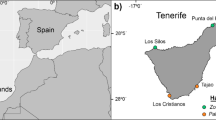Abstract
Zoanthids comprise an order of benthic, generally colonial cnidarians, which can usually be distinguished from other hexacorallians by embedded sand and detritus in their mesoglea to help strengthen their structure. These animals are becoming increasingly important research subjects in biochemistry and other research fields. Their inclusion of both calcium and silica results in the need for both decalcification and desilification for internal morphological examinations. Since the methodology of hydrofluoric acid (HF) desilification has rarely been documented in zoanthids, histological surveys for zoanthid taxonomy have often been abandoned and their taxonomy is often problematic. Recent investigations utilizing molecular methods have brought a clearer understanding of zoanthid diversity, but standardization of HF treatments are still needed to provide a link between molecular and more traditional techniques, and to properly examine specimens for which molecular methods may not be an option (e.g., formalin-preserved specimens, etc.). Here, we use both “straight” HF and, for the first time with zoanthids, buffered HF (BHF) treatments at different treatment lengths (1–48 h) on polyps from three different species of zoanthids for histological examination. Section conditions were judged based on the presence/absence of embedded detritus, drag marks, and tissue condition. Results show that the BHF treatment resulted in slightly better tissue conditions for all specimens, and suggest that desilification works well regardless of treatment time for species with smaller (polyp diameter <0.5 cm), less heavily encrusted polyps. Desilification of heavily encrusted Palythoa mutuki polyps were still problematic, with at least 24 h treatment needed. To aid future research, we provide guidelines for HF treatments of zoanthid specimens.





Similar content being viewed by others
References
Babcock RC, Ryland JS (1990) Larval development of a tropical zoanthid (Protopalythoa sp.). Invertebr Repr Dev 17:229–236
Behenna DC, Stockdill JL, Stoltz BM (2008) The biology and chemistry of the zoanthamine alkaloids. Angew Chem Int Ed 47:2365–2386
Burnett WJ, Benzie JAH, Beardmore JA, Ryland JS (1997) Zoanthids (Anthozoa, Hexacorallia) from the Great Barrier Reef and Torres Strait, Australia: systematics, evolution and a key to species. Coral Reefs 16:55–68
Cui Z (2006) Micro-nanofabrication: technologies and applications. Higher Education Press & Springer, Beijing
Fukuzawa S, Hayashi Y, Uemura D, Nagatsu A, Yamada K, Ijuin Y (1995) The isolation and structure of five new alkaloids, norzoanthamine, oxyzoanthamine, norzoanthamine, cyclozoanthamine, and epizoanthamine. Heterocycl Commun 1:207–214
Haywick DW, Mueller EM (1997) Sediment retention in encrusting Palythoa spp.—a biological twist to a geological process. Coral Reefs 16:39–46
Hoffman K, Hermanns-Clausen M, Buhl C, Buchler MW, Schemmer P, Mebs D, Kauferstein S (2008) A case of palytoxin poisoning due to contact with zoanthid corals through a skin injury. Toxicon 51:1535–1537
Kikuyama H, Miki N, Saka K, Takano J, Kawanabe I, Miyashita M, Ohmi T (1991) Principles of wet chemical processing in ULSI microfabrication. IEEE T-SM 4:26–35
Moore RE, Scheuer PJ (1971) Palytoxin: a new marine toxin from a coelenterate. Science 172:495–498
Peters D, Miethchen R (1996) Symptoms and treatment of hydrogen fluoride injuries. J Fluorine Chem 79:161–165
Ravindran J, Raghukumar C, Raghukumar S (2001) Fungi in Porites lutea: association with healthy and diseased corals. Dis Aquat Org 47:219–228
Reimer JD (2007) Preliminary survey of zooxanthellate zoanthid diversity (Hexacorallia: Zoantharia) from southern Shikoku, Japan. Kuroshio Biosphere 3:1–16, and 7 pls
Reimer JD, Ono S, Fujiwara Y, Takishita K, Tsukahara J (2004) Reconsidering Zoanthus spp. diversity: molecular evidence of conspecificity within four previously presumed species. Zool Sci 21:517–525
Reimer JD, Ono S, Iwama A, Tsukahara J, Takishita K, Maruyama T (2006) Morphological and molecular revision of Zoanthus (Anthozoa: Hexacorallia) from southwestern Japan with description of two new species. Zool Sci 23:261–275
Reimer JD, Nonaka M, Sinniger F, Iwase F (2008a) Morphological and molecular characterization of a new genus and new species of parazoanthid (Anthozoa: Hexacorallia: Zoantharia) associated with Japanese red coral (Paracorallium japonicum) in southern Japan. Coral Reefs 27:935–949
Reimer JD, Sinniger F, Hickman C (2008b) Zoanthid diversity (Anthozoa: Hexacorallia) in the Galapagos Islands: a molecular examination. Coral Reefs 27:641–654
Reimer JD, Sinniger F, Nonaka M, Uchida S (2009) Non-invasive internal morphological examination of epizoic zoanthids utilizing CT scanners. Coral Reefs 28:621. doi:10.1007/s00338-009-0487-7
Ryland JS, Babcock RC (1991) Annual cycle of gametogenesis and spawning in a tropical zoanthid, Protopalythoa sp. Hydrobiologia 216(217):117–123
Ryland JS, Westphalen D (2004) The reproductive biology of Parazoanthus parasiticus (Hexacorallia: Zoanthidea) in Bermuda. Hydrobiologia 530(531):411–419
Shiroma E, Reimer JD (2009) Investigations into reproductive patterns, ecology and morphology in the zoanthid genus Palythoa (Cnidaria: Anthozoa: Hexacorallia) in Okinawa, Japan. Zool Stud (in press)
Sinniger F, Haussermann V (2009) Zoanthids (Cnidaria: Hexacorallia: Zoantharia) from shallow waters of the southern Chilean fjord region with the description of a new genus and two new species. Org Divers Evol 9:23–36
Sinniger F, Montoya-Burgos JI, Chevaldonnè P, Pawlowski J (2005) Phylogeny of the order Zoantharia (Anthozoa, Hexacorallia) based on the mitochondrial ribosomal genes. Mar Biol 147:1121–1128
Swain TD (2009) Isozoanthus antumbrosus, a new species of zoanthid (Cnidaria: Anthozoa: Zoanthidea) symbiotic with Hydrozoa from the Caribbean, with a key to hydroid and sponge-symbiotic zoanthid species. Zootaxa 2051:41–48
Walsh GE, Bowers RL (1971) A review of Hawaiian zoanthids with descriptions of three new species. Zool J Linn Soc 50:161–180
Acknowledgements
Fumihito Iwase (Managing Director, BIK) and Junko Fukada (President, BIK) are thanked for their assistance with arranging the experiment at Stella Chemifa Corporation (Osaka, Japan). This study was supported in part by the following research grants and/or programs to J.D. Reimer: the Darwin Initiative Project (Galapagos specimen collection), Fujiwara Natural History Foundation (Tokyo, Japan), the 21st Century Center of Excellence Program and the Rising Star Program for Subtropical Island Sciences at the University of the Ryukyus.
Author information
Authors and Affiliations
Corresponding author
Rights and permissions
About this article
Cite this article
Reimer, J.D., Nakachi, S., Hirose, M. et al. Using Hydrofluoric Acid for Morphological Investigations of Zoanthids (Cnidaria: Anthozoa): A Critical Assessment of Methodology and Necessity. Mar Biotechnol 12, 605–617 (2010). https://doi.org/10.1007/s10126-009-9249-3
Received:
Accepted:
Published:
Issue Date:
DOI: https://doi.org/10.1007/s10126-009-9249-3




